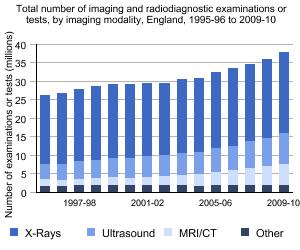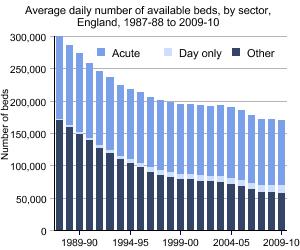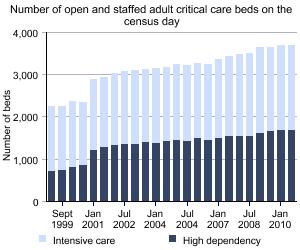This topic covers statistical outputs that provide measures of the capacity and activity carried out in NHS Trusts and Foundation Trusts.
Publications
Monthly data on A&E admissions, cancelled operations, and critical care bed use
Weekly data on A&E activity and patients waiting over 4 hours for admission, transfer or discharge, as well as ambulance data including numbers of urgent journeys and Category A and B calls.
The total number of attendances in the week for all A&E types, including Minor Injury Units and Walk-in Centres, and of these, the number discharged, admitted or transferred within four hours of arrival. Also included are the number of admissions via A&E, and any waits of over four hours for admission following decision to admit. Data are shown at provider organisation level, from NHS Trusts, NHS Foundation Trusts, Primary Care Trusts and Independent Sector Organisations.
Monthly data on delayed transfers of care
Bed availability and bed occupancy.

Statistics on women aged 50 to 70 invited for regular breast screening to detect cancers under a national programme.

Statistics on women aged 50 to 70 invited for regular breast screening to detect cancers under a national programme.
Critical care beds.
Monthly data on critical care bed use and cancelled operations
The Survey of Domiciliary Care Providers Northern Ireland, is based on the findings from a self-completed postal survey of 154 providers of domiciliary care across the statutory, voluntary and independent sectors in Northern Ireland. The survey elicited providers views on; domiciliary practices and procedures, the extent to which the views of users informed providers decisions and providers views of the degree to which they considered they were meeting regulations and minimum standards of domiciliary care.
This statistical bulletin presents information on the number of clients receiving domiciliary care services from the statutory and independent sectors during a survey week. It provides information on the number of domiciliary care contact hours provided, the number of client visits and the number of clients receiving domiciliary care during this survey week.

Presents information from a variety of sources to give a picture of the number of people benefiting from free personal care and free nursing care in Scotland, and how much Local Authorities spend on personal care services.
This statistical bulletin presents information on hearing aid assessments and re-assessments by audiologists in Northern Ireland. Information has been derived from the quarterly collection AUD1 and monitors information on both adults and children fitted and assessed for hearing aids during the quarter, complaints received, and cost of hearing aids issued. In addition, the collection monitors complete and incomplete waits for assessment during the quarter and the length of time patients were waiting or had waited following referral to an audiologist (specified time bands).
Monthly activity data relating to elective and non-elective inpatient admissions (or first finished consultant episodes FFCEs) and outpatient referrals and attendances for first consultant outpatient appointments.
The data provides a central source of information on the estates and facilities services in the NHS. It covers such aspects as the size of the estate, quality of its buildings, energy efficiency and sustainability data, hospital cleaning and hospital food.
Quarterly release of the Hospital Standardised Mortality Ratios (HSMR's) of all hospitals participating in the Scottish Patient Safety Programme

Imaging and radio diagnostics.
Hospital Site final reports from the Scottish Inpatient Patient Experience Survey
This compendium of local statistics on alcohol and drug use brings together local data from available national sources. The statistics are primarily intended to provide easily accessible information to Alcohol and Drug Partnerships to support local planning and service provision. The statistics cover both newly analysed data and previously published data.
First annual update of the set of headline indicators recommended in the Equally Well report of the ministerial task force on health inequalities.
Number of breaches of the policy on Mixed Sex Accommodation in relation to sleeping accomodation for the month, broken down by provider and commissioner.
This Statistical Release gives summary information, provided by the NHS, on bed use.
Statistics on NHS Expenditure Programme Budgets include data for Local Health Boards (LHBs) in Wales and Health Commission Wales (HCW)
A set of indicators across the five NHS Outcomes Framework domains, presented at national level.
The National Bereavement Survey (VOICES) is conducted by the Office for National Statistics on behalf of the Department of Health. The aims of the survey are to assess the quality of care delivered in the last three months of life for adults who died in England and to assess variations in the quality of care delivered in different parts of the country and to different groups of patients.

Older People Services Measuring Relative Needs
PEAT (Patient Environment Action Team) was introduced in April 2001 as a direct response to the NHS Plan. Under the programme, every NHS inpatient healthcare facility in England with more than ten beds is assessed annually and given a rating of Excellent, Good, Acceptable, Poor or Unacceptable across 3 elements; Environment (including cleaning), Food and Privacy & Dignity.
PLACE (Patient-Led Assessments of the Care Environment) was introduced in April 2013 to replace the former Patient Environment Action Team (PEAT) programme. The programme is voluntary and is open to all NHS and independent sector hospitals, hospices and treatment centres. Through this programme hospitals, in collaboration with patient assessors, undertake an annual assessment to a standard format of their non-clinical services including, but not limited to, cleanliness, condition and appearance

Annual report on registered Care Homes in Scotland
Presents provisional results from the monitoring of the NHS Stop Smoking Services in England. This report includes information on the number of people setting a quit date and the number who successfully quit at the four week follow-up.
The surgical profiles project aims to lead to improvements in patient care by making better use of existing Scotland-wide data sources. The surgical profile comprises clinical indicators about the surgical care provided by an NHS Board and its hospitals (data are not presented for individual clinicians or patients). It is a tool designed to be interpreted and used locally by those providing surgical care to stimulate reflection on surgical services.
Overview
The statistics on the Health system’s hospitals and facilities measure the capacity of NHS Trusts and Foundation Trusts, and also the activity carried out by these organisations.
These include:
-
NHS Bed availability and occupancy
-
NHS Critical care census
-
Imaging and Radio-diagnostic examinations or tests
-
Mixed Sex Accommodation breaches
Technical Data
Bed availability and occupancy
This information provides a count of available and occupied bed days by broad ward classification. It includes both inpatient, day case and residential beds across all sectors of the NHS. The source is the KH03 annual return from NHS trusts and relates to available and occupied bed days over a 12-month period between 1 April of one year and 31 March of the following year.
Availability and occupancy are measured at midnight so by definition there cannot be more than one patient occupying the bed. Therefore, bed occupancy, that is occupied beds as a percentage of available beds, never exceeds 100 per cent.
Critical Care census
The census provides a national count of critical care beds and enables provision to be measured on a consistent basis across all trusts. The census is taken twice a year, once in January and once in July. The census is collected from NHS Trusts in England and provides a count of the number of adult intensive care beds and adult high dependency beds available on census day.
Imaging and Radio-diagnostic examinations or tests
This information provides a count of imaging and radiodiagnostic examinations or tests by imaging modality, that is CT, MRI, radiographs, obstetric ultrasound, non-obstetric ultrasound, radio-isotopes and fluoroscopy. The source is the KH12 annual return from NHS Trusts and relates to imaging and radiodiagnostic examinations or tests carried out over a 12 month period between 1 April of one year and 31 March of the following year.
Mixed Sex Accommodation breaches
This information provides a count each month of all occurrences of unjustified mixing (i.e. breaches) of the Mixed-Sex Accommodation (MSA) guidance relating to English NHS patients in hospital sleeping accommodation. The source is the monthly MSA data return from NHS Trusts and other providers of NHS funded care.
An MSA breach rate is also provided alongside counts of breaches to enable comparison between healthcare provider organisations. This is the number of MSA breaches of sleeping accommodation per 1,000 episodes of admitted hospital care.
Glossary
-
Bed availability
The average number of beds available (or occupied) at midnight in each NHS Trust in England.
-
Bed occupancy rate
The average number of beds occupied at midnight divided by the average number of beds occupied or available.
-
Critical Care beds available
A count of available (or occupied) beds in intensive care and high dependency units.
-
CT
Computed tomography (CT), sometimes called CAT scan, uses special x-ray equipment to obtain image data from different angles around the body, then uses computer processing of the information to show a cross-section of body tissues and organs.
-
Fluoroscopy
Fluoroscopy is an imaging technique commonly used by physicians to obtain real-time images of the internal structures of a patient through the use of a fluoroscope. In its simplest form, a fluoroscope consists of an x-ray source and fluorescent screen between which a patient is placed.
-
High Dependency Unit
A subset of intensive care, a high dependency unit (HDU) is an area for patients who require more intensive observation, treatment and nursing care than are usually provided on a general ward. It is a standard of care between the general ward and full intensive care.
-
Imaging and Radiodiagnostics
A set of examinations or tests including CT, MRI, radiographs, obstetric ultrasound, non-obstetric ultrasound, radio-isotopes and fluoroscopy.
-
Intensive Care
Intensive care is needed to care for patients in a life-threatening condition, who need continuous monitoring and treatment. Intensive care units (ICUs) are small, specialised wards, which usually have less than 12 beds, higher numbers of staff, and specialist medical equipment. ICUs receive patients from other hospital wards, high dependency units, direct from surgery or surgical wards, and from accident and emergency departments. When a patient is admitted to an ICU, they are cared for by an intensive care specialist, as well as the treatment team who cared for them when they were first admitted to hospital, plus any other specialists who may be able to help with their recovery.
-
Mixed-sex accommodation breach
When a patient shares hospital sleeping accommodation with other patients of the opposite gender when it is not in their best interest or does not reflect their personal choice.
-
MRI
Magnetic resonance imaging (MRI) is a method of producing extremely detailed pictures of body tissues and organs without the need for x-rays. The electromagnetic energy that is released when exposing a patient to radio waves in a strong magnetic field is measured and analysed by a computer, which forms two- or three-dimensional images that may be viewed on a TV monitor.
-
Neonatal intensive care (NIC)
Some intensive care units have separate units attached to care specifically for newborn babies. Approximately 10 per cent of babies need special medical support when they are born, and 1-3 per cent often need neonatal intensive care for several weeks.
-
Paediatric intensive care (PIC)
Paediatric ICUs are for children who are under the age of 16, although most of the children that need PIC are under one year old. Older children and teenagers may receive care in a normal adult ICU, or a paediatric ICU, depending on where they feel most comfortable.
-
Radio-isotopes
Radioactive materials (radioisotopes or radionucleides) used to pinpoint disease. It reveals the size and shape of the target organ and whether any part of it is failing to take up radioactive material, usually an indication of disease.The speciality known as nuclear medicine makes use of the affinity of different chemical elements for certain parts of the body.
-
Sleeping accommodation
Includes areas where patients are admitted and cared for on beds or trolleys, even where they do not stay overnight. It therefore includes all admissions and assessment units (including clinical decision units), plus day surgery and endoscopy units. It does not include areas where patients have not been admitted, such as accident and emergency cubicles.
Contact Details
For statistical enquiries about this topic, please contact:
Knowledge and Intelligence
Email: unify2@dh.gsi.gov.uk
Telephone: +44 (0) 1132 545214
Room 4E60 Quarry House Quarry Hill Leeds LS2 7UE



